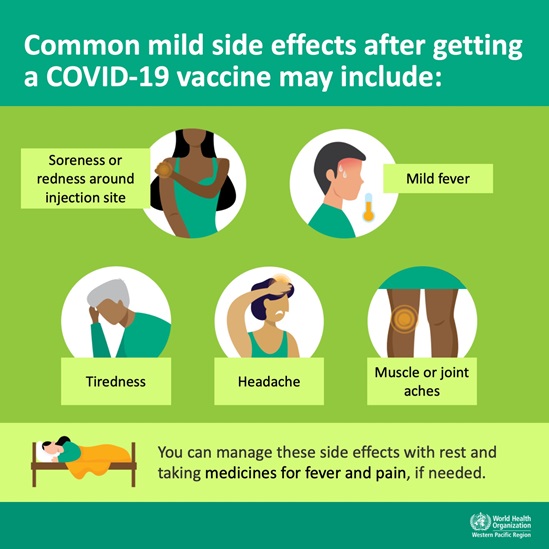General information about COVID-19
COVID-19 is the disease caused by a new coronavirus called SARS-CoV-2. WHO first learned of this new virus on 31 December 2019, following a report of a cluster of cases of ‘viral pneumonia’ in Wuhan, People’s Republic of China.
The Most common symptoms are fever, dry cough and fatigue
Other symptoms that are less common and may affect some patients include:
Loss of taste or smell, • Nasal congestion, • Conjunctivitis (also known as red eyes) • Sore throat, • Headache, • Muscle or joint pain, • Different types of skin rash, • Nausea or vomiting, • Diarrhea, • Chills or dizziness.
Symptoms of severe COVID‐19 disease include:
• Shortness of breath, • Loss of appetite, • Confusion, • Persistent pain or pressure in the chest, • High temperature (above 38 °C).
Other less common symptoms are:
• Irritability, • Confusion, • Reduced consciousness (sometimes associated with seizures), • Anxiety, • Depression, • Sleep disorders, • More severe and rare neurological complications such as strokes, brain inflammation, delirium and nerve damage.
People of all ages who experience fever and/or cough associated with difficulty breathing or shortness of breath, chest pain or pressure, or loss of speech or movement should seek medical care immediately. If possible, call your health care provider, hotline or health facility first, so you can be directed to the right clinic.
We know that the disease is caused by the SARS-CoV-2 virus, which spreads between people in several different ways.
The virus can spread from an infected person’s mouth or nose in small liquid particles when they cough, sneeze, speak, sing or breathe. These particles range from larger respiratory droplets to smaller aerosols.
•Current evidence suggests that the virus spreads mainly between people who are in close contact with each other, typically within 1 metre (short-range). A person can be infected when aerosols or droplets containing the virus are inhaled or come directly into contact with the eyes, nose, or mouth.
•The virus can also spread in poorly ventilated and/or crowded indoor settings, where people tend to spend longer periods of time. This is because aerosols remain suspended in the air or travel farther than 1 metre (long-range).
People may also become infected by touching surfaces that have been contaminated by the virus when touching their eyes, nose or mouth without cleaning their hands.
Further research is ongoing to better understand the spread of the virus and which settings are most risky and why. Research is also under way to study virus variants that are emerging and why some are more transmissible. For updated information on SARS-CoV-2 variants
Whether or not they have symptoms, infected people can be contagious and the virus can spread from them to other people.
Laboratory data suggests that infected people appear to be most infectious just before they develop symptoms (namely 2 days before they develop symptoms) and early in their illness. People who develop severe disease can be infectious for longer.
While someone who never develops symptoms can pass the virus to others, it is still not clear how frequently this occurs and more research is needed in this area.
There are many things you can do to keep yourself and your loved ones safe from COVID-19. Know your risks to lower risks. Follow these basic precautions:
•Follow local guidance: Check to see what national, regional and local authorities are advising so you have the most relevant information for where you are.
•Keep your distance: Stay at least 1 metre away from others, even if they don’t appear to be sick, since people can have the virus without having symptoms.
•Wear a mask: Wear a well-fitting three-layer mask, especially when you can’t physically distance, or if you’re indoors. Clean your hands before putting on and taking off a mask.
•Avoid crowded places, poorly ventilated, indoor locations and avoid prolonged contact with others. Spend more time outdoors than indoors.
•Ventilation is important: Open windows when indoors to increase the amount of outdoor air.
•Avoid touching surfaces, especially in public settings or health facilities, in case people infected with COVID-19 have touched them. Clean surfaces regularly with standard disinfectants.
•Frequently clean your hands with soap and water, or an alcohol-based hand rub. If you can, carry alcohol-based rub with you and use it often.
•Cover your coughs and sneezes with a bent elbow or tissue, throwing used tissues into a closed bin right away. Then wash your hands or use an alcohol-based hand rub.
•Get vaccinated: When it’s your turn, get vaccinated. Follow local guidance and recommendations about vaccination.
Since the start of the COVID-19 outbreak, WHO has worked with countries and areas in the Western Pacific Region on public health measures to slow or stop the spread of the virus. In 2021, safe and effective vaccines will be an important tool, in combination with other measures, to protect people against COVID-19, save lives and reduce widescale social disruption.
Some countries and areas in the Western Pacific Region have already completed regulatory approval and started introducing one or more COVID-19 vaccines. Other countries are getting ready to do so.
Through the COVAX Global Vaccine Facility and other mechanisms, WHO and partners are working with governments to facilitate equitable access to and distribution of an initial allocation of vaccine as quickly as possible.
WHO recommends that initial vaccination should prioritize groups at highest risk of exposure to infection in each country, including health workers, older persons and those with other health issues. Once COVID-19 vaccines become more available, countries can expand to vaccinate other priority groups and the general population.

